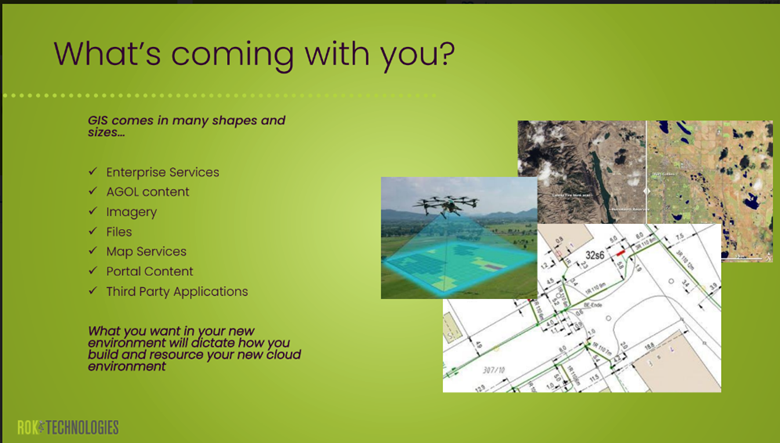This article brought to you by ROK Technologies.
Migrating to the cloud is more than just a server and software upgrade. It’s a transformation in how you manage technology. Many organizations are currently at a crossroads: migrate to a cloud environment or maintain the status quo.
Although on-premise data centers are still a reality, cloud migration provides unmatched opportunities for growth. The cloud can help you lower costs, become more agile, develop new skills more quickly, and deliver reliable, globally available services to your customers. Imagery, big data, analytics, and the continually expanding capabilities of your Esri ArcGIS Enterprise stack make migrating from on-premise to a GIS Managed Cloud Services solution an ideal choice.
The #1 reason GIS organizations move to the cloud is to liberate their GIS from the constraints of on-premise systems, management, and infrastructure. While the benefits are great, preparing for the process of cloud migration requires an investment of time and energy from the right people. It is important to plan before starting your cloud journey. If your organization wants to increase scalability, security, control, productivity, enhance collaboration, and modernize GIS, there are many things to consider to make the transition as smooth and successful as possible.
Here are 5 key considerations to ensure that your IT & GIS departments have everything needed to make your organization’s cloud migration a reality.
Consideration 1: Who needs to be a part of the cloud journey?
Build your team before you start the work. If your organization’s roles and processes are built around on-premises environments, shifting to a cloud infrastructure can cause a steep learning curve. As a result, moving to the cloud may require redefining roles, rewriting processes, hiring new team members, and collaborating with a skilled partner with expertise in managing GIS and IT infrastructure migration. Change management and user adoption is an important part of preparing for a migration. Excited and involved end users will help, not hinder the transition ahead.
PRO TIP: Hire a project manager to facilitate all of the moving parts. A focused project manager will assume complete ownership of the project—from start to finish—freeing you up to focus on your day-to-day responsibilities.
Consideration 2: What do we need to migrate?
Decide what is vital to your business that you want to take with you. Just because you have the data doesn’t mean you need it. This is a great opportunity to get rid of all of the services and data that have simply been “taking up space”. Outdated workflows and behaviors can be left behind as you build a new optimized GIS environment in the Cloud.
Documenting the types of data you have (and where it lives) into an inventory list will save time down the road; the cleaner and more organized your house is, the easier it is to move!
Not sure where to start? If you need help determining what to take with and what to leave behind, think about completing a cloud assessment. The Cloud Managed Services Assessment helps provide the insights that ROK needed to ensure the best designed architecture to take your organization to the cloud.
PRO TIP: Migration is a perfect time to ensure you are running the most up to date software and adding any new services to your stack.
Consideration 3: What will it take to get there?
Create a budget and timeline. Budget can determine your when. Be sure to start planning your journey well in advance of your desired start date. Ensure the team is ready to go; is informed of the tasks they need to complete; and Project Manager has been identified to keep everyone on track. If you are migrating existing services and applications, build in time for testing performance once they get into the cloud and before you go live. If transitioning to ArcGIS Enterprise, make sure to leave extra time to train employees on new workflows and possibilities.
There are 4 key phases of every cloud migration:
- Deploying the cloud environment
- Installing and configuring the ArcGIS services in the environment
- Migrating existing services and data into the environment
- Quality assurance testing, cut over and onboarding of GIS staff
The first step is to make sure you have made the financial case to move to the cloud. If you need help, use an ROI calculator to better understand the total cost of ownership, financial impact to CapEx/Opex, potential savings and more.
Some of the most commonly asked business questions around GIS cloud migration.
- How to calculate your current on premise cost, including the cost of hardware, server space, server age, cost of employees to manage the hardware, etc.
- How to quantify the lost opportunity costs, like speed, productivity and scale.
- How to calculate ROI so it is easier to foresee the results of the investment.
- How to properly assess where you are organizationally to better define the scope and level of effort involved in a GIS cloud migration
PRO TIP: Pad the budget by 15-20% - especially if you are planning far in advance.
Consideration 4: What cloud solution do we invest in?
There are many cloud provider options available; it is simply finding the one that works best for your GIS organization. There are plenty of checklists and best practices articles available to familiarize yourself with what is available.
In 2022, the top three cloud providers in are:
- Amazon Web Services (AWS), with 62% of the market,
- Microsoft Azure, with 20%, and
- Google Cloud Platform (GCP), with 12%.
There are definitely other big players like Oracle and IBM as well as new niche providers entering the space. No matter the provider; it is important to do your due diligence before making a selection to make sure the provider aligns with your exact needs. A GIS managed cloud services partner, like ROK Technologies can help you determine what your GIS organization needs in a cloud provider. You don’t have to go it alone! A managed cloud services partner will assist you in the process and provide knowledge and expertise along the way.
Consideration 5: Why partner with a Cloud Managed Services?
It’s impossible to get all the answers you need if you don’t even know the questions to ask. There is no substitute for been-there-done-that skills and experience. Working with a partner who can guide you every step of the way can highlight what you need to know and may not know.
PRO TIP: Beware of out-of-the box solutions, no two GIS migrations are the same, unless you are starting from scratch.
“What we want to do at ROK Technologies is become an extension of your GIS department. We want to be your trusted advisor to free your IT guys up as well as free up your GIS staff to focus on GIS products and services. We also want you to be in a strong position to take advantage of your Esri investment and the different extensions the enterprise rolls out; and to help you utilize the licensing that you're paying for.” - Alex Coleman, ROK Technologies, CEO
Migrating to the cloud is a strategic decision that GIS organizations make because there are significant benefits to be gained. If you’re not truly ready—with all the planning, preparation, and confidence —you could be putting your business strategy at risk. But remember, you don’t have to do this alone.
Why Listen to Us?
At ROK Technologies we focus solely on architecting, deploying, and managing ArcGIS in the Cloud. We take the day to day management of your Esri Enterprise software and its supporting infrastructure off your plate; so you can focus on what you do best, GIS.
As a longtime Esri business partner and Esri Cloud Specialty partner, our certified implementation experts work with the best cloud providers - AWS, Azure and GCP; and most importantly, we work with YOU and your organization to develop the right fit solution for your needs. We take your GIS to the Cloud.
“Over 70% of our clients have expanded their GIS footprint since moving to the cloud.”
Need more proof? Read How AEC firm, GAI Consultants gained speed, efficiency and IT support migrating to the cloud.
PRO TIP: Looking for assistance moving your GIS to the cloud? Contact us at info@roktech.net or call 888.898.3404.





